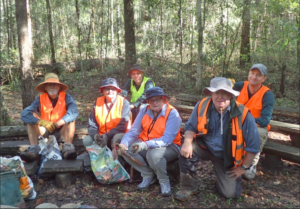Protected Magazine
Volunteering Matters
Last year I wrote an article about NPAQ’s vegetation management group in D’Aguilar National Park for NPAQ’s 80 year anniversary, but there’s so much more going on with volunteers in the D’Aguilar area.
There are six other groups out and about contributing in a big way to park management. While many of us are sleeping in on weekends, or even mid-week, there are dedicated, passionate volunteers out doing their thing. There are three main categories of volunteer groups working in and around D’Aguilar. They are made up of three bush-care groups, two recreation trail maintenance groups, and a visitor engagement group.
The groups include Moggill and Bunyaville Conservation Park Bush-care group, NPAQ Vegetation Management Group, Northside Trail-care Alliance (NTCA), Brisbane Bushwalkers, and D’Aguilar Mobile Public Contact Volunteers. A total of about 60 active volunteers currently contribute to these groups.


QPWS has finite resources, so the groups need to be self-sufficient and have motivated group leaders to organise and lead the activities. This is key for volunteer groups to be successful and self-sustaining.
For this article, I’ll focus more on the D’Aguilar Mobile Public Contact Volunteers (MPCV) to help celebrate their 20 years of volunteering with the program. But before I do, it’s important to recognise the significant contribution made by the other groups whose activities have also been running for many years, with the two other bush-care groups being in their 15th year, the trail care group in their 21st year, and the NPAQ group up to their 33rd official year (their 37th unofficial year).


The bush-care groups have made significant inroads into reducing threatening processes from invasive plant species impacting the natural diversity of the parks. They primarily target riparian corridors in Moggill and Bunyaville Conservation Parks. Thousands of volunteer hours have been spent treating highly invasive species. The outcomes from their pest control activities have been incredible, resulting in a significant reduction in the spread of pest-plant species in the parks.
The same can be said for the trail-care group NTCA; they are equally committed to maintaining trails to achieve best practice for both trail sustainability and ride quality. Brisbane Bushwalkers also undertake an annual large-scale working bee focusing on walking tracks, signage maintenance, remote bush-camps and other park infrastructure.
Other volunteer groups that also contribute significantly to park protection include the multiple Rural Fire Brigades situated in and around the D’Aguilar Range, the local SES groups that assist Queensland Police with search and rescues, and the Mount Nebo/Glorious Environmental Protection Association (MEPA) who undertake significant pest-plant control works in the southern part of the D’Aguilar Range.
20 years of D’Aguilar Mobile Public Contact Volunteers Kudos for this initiative goes to Denis Taylor, a long-term volunteer now in his 38th year of volunteering in D’Aguilar National Park, starting with the ‘Go Bush’ program in 1985.
Denis organises the roster for several volunteer activities each month, with alternating volunteer patrols to both the northern and southern parts of D’Aguilar National Park. Denis has had some long-term support from Alison Davis and Mike Corrie who have also been volunteering in the park, each for 25 years. Newer members of this volunteer team also bring a breadth of knowledge and experience to the group.
The initial idea of the volunteer patrol was to supplement ranger patrols with public contact volunteers who could provide information and advice to the public about the park’s natural history and attractions. They visit key visitor sites and interact with the public. In addition, they report issues like facility breakdowns and vandalism to the local work unit, and they clean and maintain boardwalks, carparks and interpretive nodes with blower vacs to improve presentation value. They initiate general litter collection at picnic areas, and they deliver visitor guides to key visitor centres and businesses around the D’Aguilar Range.
Once a month, they also provide a visitor-counter download, which involves collecting visitor data from trail counters out in the park. Counters are located on walking tracks, mountain-bike trails and horse trails, at facilities like toilet blocks, and at vehicle entrance roads and carparks. This data collection is crucial for management planning to monitor trends of use, and to assist with decision making around capital works planning. The visitor data helps assist with the prioritisation of site re-developments for visitor facilities like day use areas, trail hubs and campgrounds.
This group of volunteers also undertake visitor surveys from time to time to get a snapshot of the public’s feedback about the many visitor sites across the range. Having a volunteer patrol frequenting the park a couple of times a month, and flying the conservation flag, helps with combating negative behaviours.
Managing D’Aguilar protected areas so close to a major capital city is challenging. There are multiple visitor nodes that each experience very high numbers of visitors, and the parks suffer increasing edge effects with widening urban interface zones.
It’s difficult for rangers to keep up with the demands of working in such a busy space, however working in partnership with such supportive community groups is one way to relieve some of the pressures.
Welcoming and harnessing this support from the community is a positive way to assist in managing our protected areas.


